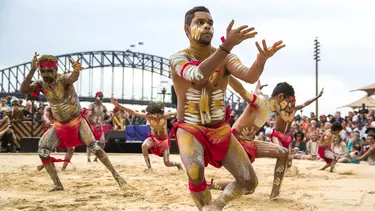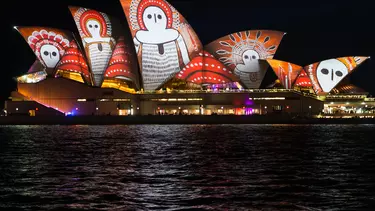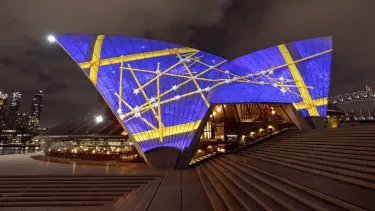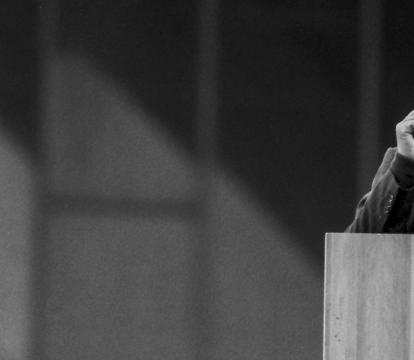Our story50 years of extraordinary moments
Australian culture reached a remarkable milestone on 20 October 1973: the completion of one of the greatest buildings of the 20th century and the birth of a new cultural experiment on Sydney harbour.
“The Sydney Opera House has captured the imagination of the world, though I understand that its construction has not been totally without problems,” Queen Elizabeth II observed, officially opening Jørn Utzon’s masterpiece on a blustery spring day. But as the Queen went on to say: “The human spirit must sometimes take wings or sails and create something that is not just utilitarian or commonplace.”
Queen Elizabeth IIThe human spirit must sometimes take wings or sails, and create something that is not just utilitarian or commonplace.
Ben Blakeney, a direct descendant of Bennelong, appeared silhouetted at the apex of one of the high roof sails to welcome the public to the Opera House.
It was a day that brought to a conclusion the saga of the building’s conception, design and construction, a saga in which controversies and politics upended what had seemed for many years an idealistic quest for architectural perfection.
Some had feared that the Opera House might never be finished. To others, its perfection had been forever compromised by the manner of its completion. But on 20 October, as the building opened, those with long memories may also have recalled the aspirations of former NSW Premier Joe Cahill, who launched the Opera House project to “help mould a better and more enlightened community.” Now that construction was complete, Australia’s most prestigious performance space was finally open for business.
For five decades, artists from around the world have expressed a sense of awe in the presence of the Opera House. In March 2024, when Chicago indie veterans Wilco played in the Concert Hall, the band’s lead singer and songwriter Jeff Tweedy paused between songs to take in the moment: “It’s like playing inside someone’s sculpture.” The sentiment later came to life in Benjamin Millepied’s Romeo & Juliet Suite, from the LA Dance Project, when the dancers used the physical form of the building to glorious effect.
A history of spectacular moments
The Opera House was born of an urgent need for new creative expression. Its construction was a bold, visionary exercise in nation-building by a young, largely immigrant nation looking to define itself.
The urgency was also underlined by the fact that the first performance at the Opera House occurred long before the building had even been finished. In 1960, before the construction of the sails had even begun, American singer and civil rights activist Paul Robeson climbed the scaffolding and sang Ol’ Man River to construction workers.
On 28 September 1973, almost a month before its official opening by Her Majesty the Queen, the curtain in the Opera Hall rose on its first production: Prokofiev’s epic War and Peace, performed by the Australian Opera. The first performance in the Concert Hall was a program of works by Wagner performed by the Sydney Symphony Orchestra and featuring the legendary Swedish soprano Birgit Nilsson and conductor Charles Mackerras. The Music Room – now the Utzon room – was home to Musica Viva, the chamber music organisation set up in the 1940s by a Hungarian refugee to meet the burgeoning demand for classical music from European migrants. The Old Tote Theatre – later the Sydney Theatre Company – moved into the Drama Theatre.
By the Opera House’s second year, new Australian works included The Australian Opera’s staging of Peter Sculthorpe’s Rites of Passage and The Australian Ballet’s performance of Barry Moreland’s Sacred Space. The Opera House’s repertoire extended far beyond opera, ballet, symphonic music and theatre with performances of jazz, including Sammy Davis Jnr in 1977 and Ella Fitzgerald in 1978, as well as a wide variety of pop and rock shows.
In 1974, Australia’s greatest opera star, Joan Sutherland, performed for the first time in the theatre that would be named for her. The Australian Opera’s production of Offenbach’s The Tales of Hoffman was the first of many times La Stupenda would tread the boards of the Opera House’s stages. Her performances included Lakmé, Norma and The Merry Widow in the 1970s, and Lucia di Lammermoor, Otello, La Traviata and Die Fledermaus in the 80s. Dame Joan farewelled the Opera House in 1990 with a performance of Les Huguenots. She received a rapturous reception, with green and gold streamers thrown by the audience covering the stage. In 2012, the Sydney Opera House renamed its Opera Theatre the Joan Sutherland Theatre in memory of one of Australia's greatest opera singers.
By the Opera House’s second year, new Australian works included The Australian Opera’s staging of Peter Sculthorpe’s Rites of Passage and The Australian Ballet’s performance of Barry Moreland’s Sacred Space. The Opera House’s repertoire extended far beyond opera, ballet, symphonic music and theatre with performances of jazz, including Sammy Davis Jnr in 1977 and Ella Fitzgerald in 1978, as well as a wide variety of pop and rock shows.
In 1974, Australia’s greatest opera star, Joan Sutherland, performed for the first time in the theatre that would be named for her. The Australian Opera’s production of Offenbach’s The Tales of Hoffman was the first of many times La Stupenda would tread the boards of the Opera House’s stages. Her performances included Lakmé, Norma and The Merry Widow in the 1970s, and Lucia di Lammermoor, Otello, La Traviata and Die Fledermaus in the 80s. Dame Joan farewelled the Opera House on 2 October 1990 with a performance of Meyerbeer’s Les Huguenots, conducted by her husband, Richard Bonynge. She received a rapturous reception, with green and gold streamers thrown by the audience covering the stage. In 2012, the Opera House renamed its Opera Theatre the Joan Sutherland Theatre in memory of one of Australia's greatest opera singers.
By 1977, children’s programming was being welcomed into the Opera House with productions of Babar the Elephant and Peter and the Wolf. The following year, low-cost daytime programs began to introduce even more young audiences to the performing arts.
As the building’s fame grew, the Opera House attracted an ever-wider universe of stars and world leaders. In 1980, Arnold Schwarzenegger won his final Mr Olympia body-building title in the Concert Hall. Seven years later, the same stage hosted Pope John Paul II. In 1990, Nelson Mandela, recently freed from prison after 27 years, spoke of forgiveness to a large crowd* on the Monumental Steps.
In 1981, the ABC presented a direct radio satellite broadcast to Europe of Camille Saint-Saens’ Symphony No. 3 in C Minor performed by the Sydney Symphony Orchestra and organist Michael Dudman. It was heard by millions across Europe and was the first direct radio satellite broadcast from Australia. Two years later, the Opera House marked its 10th anniversary with performances by The Chamber Orchestra of Europe, the London Symphony Orchestra, the Choir of King’s College in Cambridge and the Academy of St Martin in the Fields.
In 1985, the Opera House presented Music and Dance of the First Australians, the first major program of works by Australia’s First Nations community. The pace of Australian works quickened: 1986 saw Voss, an opera based on the novel by Patrick White, composed by Richard Meale to a libretto by David Malouf. Graeme Murphy was also choreographing new works for Sydney Dance Company.
In 1988, as Australia celebrated its bicentenary, the revitalised forecourt became a venue for sheep shearing, hot air ballooning and a demonstration of ski jumping into the harbour. In 1990, director Baz Luhrmann and designer Catherine Murphy transported Puccini’s La Bohème into 1950s Paris, with Mimi and Rodolfo embracing on a rooftop beside a giant sign in glowing red cursive: L’amour. Seven years later, Luhrmann and Murphy married in front of the same set on the same stage.
By 1995, the extraordinary tale of the Opera House’s construction had become an opera in itself: Australian Opera’s production of The Eighth Wonder, written by composer Alan John and librettist Dennis Watkins. The following year, many thousands of people* crammed onto the Forecourt and the Monumental Steps to witness Crowded House’s Farewell to the World concert. The Melbourne-born rock group had announced they would disband and that the Opera House was to be their last performance. The evening ended with Don’t Dream it’s Over.
At the turn of the millennium, Icehouse marked the final moments of 1999 with a 25-minute version of Great Southern Land accompanied by the Australian Chamber Orchestra with Richard Tognetti playing an electric violin and Australian-based Japanese drum ensemble Taikoz.
As Sydney prepared to host the 2000 Olympics, the Opera House kicked off an Olympic Arts Festival with Tubowgule. To the sound of didgeridoos and clapsticks, dancers evoked the celebrations and ceremonies that had occurred on Bennelong Point for thousands of years. Opera singer Deborah Cheetham performed, and the Opera House’s sails were bathed in a light show designed by Marc Newson. Then in 2001, we introduced Message Sticks, an annual festival of contemporary indigenous culture.
In 2008, Brian Eno curated the first Vivid LIVE music program. Oprah Winfrey also used the Forecourt to film her Ultimate Australian Adventure, with guests including Nicole Kidman, Russell Crowe and Hugh Jackman in 2010. In that same year, 5,200 people lay naked in the very same spot in front of Spencer Tunick’s camera.
Over the years, there has been a long line of international stars who have performed on the Opera House stages, among them Sting, The Cure, Kraftwerk, The National, Björk, Patti Smith, Bob Dylan and Massive Attack. In more recent times, the Opera House has hosted unforgettable performances from Fred Again, Fever Ray, Jonas Kaufmann, Herbie Hancock, Caroline Polachek, Briggs, Angélique Kidjo, The Necks, Thom Yorke, Tones and I and many more.
According to its 1961 Act, the Opera House exists to not only promote excellence and achievement in the arts, but as a meeting place for matters of local, national and international importance. It carries out that function to this day through a year-long program that celebrates the rich vitality of First Nations culture.
The highlight of that Indigenous program was Homeground, an immersive two-day annual festival that showcased the greatest Indigenous artists from across Australia and the globe. Homeground continued the tradition established by the Message Sticks festival.
In November 2015, a new national Indigenous dance competition, DanceRites, premiered as part of Homeground. DanceRites has helped revitalise fast-vanishing Indigenous cultural leadership and practices – including language, dance, traditional instruments and skin markings – by creating a contemporary and competitive forum for performance by First Nations communities.

In 2016, the Sydney Opera House’s then Head of First Nations Programming, Rhoda Roberts, curated the annual lighting of the sails, transforming the building into a vast animated canvas for the work of six artists: Karla Dickens, Djon Mundine, Gabriella Possum Nungurrayi, Reko Rennie, Donny Woolagoodja and the late Gulumbu Yunupingu.
Titled Songlines, the work conflated time and space, weaving history lines and trade routes into a pattern of sharing systems. As the first time the Opera House’s sails had been used as a canvas exclusively for Aboriginal artists, it marked a historic moment on the land that for tens of thousands of years had been known as Tubowgule by its Gadigal custodians.

This tradition was carried forward with Badu Gili, a daily celebration of First Nations culture and history. (The title means “water light” in the language of the Gadigal.) Launched in 2017, Badu Gili featured projections of First Nations artists from across Australia on the Bennelong sails. Enabled by the Opera House, its Idealist donors and the Australia Council for the Arts, Badu Gili attracted more than 16,000 visitors in its first month, with hundreds of thousands of people later making their way to the water’s edge to witness this extraordinary daily event. We later introduced Badu Gili LIVE, a free outdoor festival on the Monumental Steps dedicated to First Nations music, art and food.
In late 2023, the Opera House launched a new chapter of Badu Gili that brought together First Nations artists from Australia and around the world in partnership with the Biennale of Sydney and the Fondation Cartier pour l’art contemporain. The first of this four-year partnership was Badu Gili: Celestial, which featured a six-minute display celebrating Meriam artist Gail Mabo, from Mer Island in the Torres Strait, and Nikau Hindin, a Te Rarawa and Ngāpuhi woman from Aotearoa/New Zealand.

Other special moments at the Opera House demonstrate the breadth of cultural experiences that have become an everyday occurrence. In April 2015, Stephen Hawking appeared as a hologram to discuss everything from theoretical physics to One Direction. The following February, audiences were treated to an intimate solo performance by Prince, part of his Piano & A Microphone Tour, in the Concert Hall. The singer died just two months later.

Nick Cave has performed several times at the Opera House, including a special solo Concert Hall appearance in January 2019, and three nights with Warren Ellis in 2023 as part of their Australian Carnage tour. Cave and Ellis later released a live recording from their Australian Carnage performances at the Opera House.
The art of comedy changed forever in September 2017, when Hannah Gadsby presented two ground-breaking shows at the Opera House, Nanette, later attracting a worldwide following as a Netflix special that won her a Peabody and Emmy award, among other accolades. The show, building on the discussions surrounding the #MeToo movement, was widely praised by critics and sparked renewed debate about misogyny, art and the contours of comedy itself.

In May 2018, Ice Cube took over the same stage, lifting the roof over two sold-out nights. The founding member of NWA is just one of the many rappers who have appeared in the Opera House in recent years, with others including Skepta, Kanye West, Lauryn Hill and the Wu-Tang Clan.
Solange Knowles performed in the Concert Hall in early 2020, a powerful show that The Guardian described as a “healing and affirming”. Her appearance was also significant for being the last Concert Hall performance before the venue closed for renovations that would last more than two years.
At least that closure had been planned. More unexpected was the arrival of COVID-19, which in March 2020 forced the Opera House, for the first time in its history, to suspend all performances and public-facing activities on site, with a significant impact on the production and events and visitor experience teams. To mark the temporary closure, “ghost lights” were placed in performance venues and the Joan Sutherland Theatre Northern Foyer - a nod to the past, but also a symbol of hope.
The pandemic hit the performing arts especially hard, so the Opera House team pivoted online to continue to connect with the community and provide work for artists. These measures included a digital program, From Our House to Yours, and a new commissioning program called New Work Now.
Meanwhile, worked continued on the refurbishment of the Concert Hall, a complex project to transform the Opera House’s largest performance space for future generations. When musicians from the Sydney Symphony Orchestra returned in June 2022, the first time in more than two and a half years, they were overwhelmed by the rich, clear sound around them.
The Concert Hall reopened to audiences on July 20, with a special performance by the Sydney Symphony Orchestra, led by its new Chief Conductor Simone Young. The evening began with the world premiere of William Barton’s Of the Earth, a new commission featuring clapsticks made from the old Concert Hall stage, then continued with a triumphant performance of Mahler’s Second Symphony, the Resurrection.
The Concert Hall refurbishment was the largest part of the Decade of Renewal, which was designed to open up more of the Opera House to the community and to enhance the creative possibilities within. The improvements included new acoustics, an accessible passageway and elevators, plus modern stage machinery to improve safety and allow faster transitions between shows. The Sydney Morning Herald’s Peter McCallum was full of praise on opening night: “The sound in the newly-refurbished Opera House Concert Hall is immaculately clear, subtly astringent with fine layering, keen edge and polished textural detail.”

With COVID-19 restrictions lifted, the Opera House welcomed back audiences for a range of performances and experiences, from the return of Six to the 10th anniversary of All About Women. Opera Australia also staged Phantom of the Opera, the Opera House debut for Andrew Lloyd Webber’s classic.
In May 2022, Vivid LIVE made its spectacular, much-anticipated return after two heartbreaking years of pandemic-related cancellations. Despite a series of challenges – the lack of international visitors, the closure of the Concert Hall and a drenching from La Nina – the event struck a chord with visitors courtesy of a diverse, locally focused program that spoke powerfully to our contemporary moment.
Then in October, we kicked off our 50th anniversary celebrations with a year-long program that encouraged everyone to share in the possibility and wonder of the Opera House. From outdoor activities to contemporary art, international spectacles to community gatherings, the program was an opportunity to reflect on how far we’d come in five decades – and also to set the stage for where we’re going next.
More than 340 events took place across the year, many free or low-cost. More than 240,000 people attended ticketed events, while almost two million people experienced free outdoor events/activities that culminated in October 2023 with the Birthday Festival and Open House Weekend. From Inside/Out at the House to What Is the City But the People?, from community choirs on the Monumental Steps to Megan Cope’s public artwork Whispers, the 50th anniversary program reflected the diversity and breadth of what the Opera House could be.
* As this event was not ticketed, attendance cannot be confirmed. Photographs from the time indicate it would not comply with today’s regulations and safety standards.
